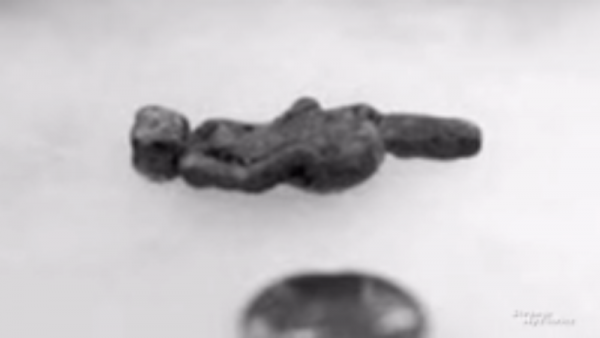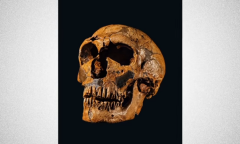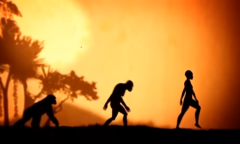By KM Diaz, | March 06, 2017

The stone doll has an intricate design which indicates that it was made by an artist. (YouTube)
Fossils have helped to shed light on life on Earth millions of years ago. However, there are some fossils that have confounded scientists.
Fossils are preserved naturally. They can be remains of creatures such as animals, plants, and humans lived in the past.
Like Us on Facebook
Scientists have failed to explain the following 14 mysterious fossils:
Martian Bacterial Fossil of ALH84001
ALH84001 fell off to Earth in 1984. When scientists tested it they found out it came from Mars and is 1.4 billion years old. The surface has traces of fossilized bacteria called Martian bacteriological fossil.
There's still no definite explanation about the origin of this Martian bacteriological fossil.
Homo naledi
A series of skeletons found in 2015 called Homo naledi falls in the family of both apes and humans.
Researchers have classified them as man-ape or evolutionary middle child. This species is believed to have existed less than a million years ago; before Homo sapiens. Still, no one knows if they are related to Homo sapiens or not.
Tully Monster
In 1955, fossil collector Francis Tully discovered an unknown creature. The appearance is quite odd; the body is like a cuttlefish and has no bones. The eyes look like a hammerhead shark that has two eye pods with long segmented arms. It is not a worm, mollusk, and not related to squids.
After a while, some samples showed that it has a spinal cord. It has been classified as early vertebrae; mystery nope fish.
Dinosaur Fossils in Frozen Arctic
Scientists recently found species of dinosaur in North Alaska. It's a mystery why these dinosaurs appeared in the cold area. Dinosaurs were generally cold-blooded; they cannot regulate their body heat. Dinosaurs are also herbivores and there were no plants in the Arctic.
It didn't look like they migrated in the place; it appeared that they lived in the Arctic.
Klerksdorp Spheres
During the mineral excavation in Ottosdal, Africa these spheres made up of hard metal mixtures were discovered. They are estimated to have been created three million years ago by advanced prehistoric civilizations.
Godzillus
Amateur fossil finder Ron Fine found chunks of fossils in Covington, Kentucky which turned out to be a giant, seven-foot-long, multi-lobed, and elliptically shaped thing. Scientists say the animal existed 450 Million years ago when the area was still underwater. It is thought to be some kind of a sea creature, due to its layers, oblong surfaces, and lobes. It is estimated to be nine-feet tall which is why it is called Godzillus.
Scientists still cannot confirm if it's a soft-bodied animal or just a plant.
Homo floresiensis
In 2003, a bone of small hominid was discovered by the Australian-Indonesian team in one of the islands in Indonesia. The animal, which existed 18,000 years ago, is called Homo floresiensis; a mysterious classification of hominid because of its size which is only 3-feet tall.
The questions are, where did they come from? If during those times Homo sapiens were the only hominids existed on the planet?
Chandra Wickramasinghe's meteorite fossils
A meteorite was discovered in Sri Lanka on December 29, 2012. It is believed to have fallen from the sky, but, Meteorite Society did not capture any record of impact.
The director of Buckingham Centre for Astrobiology in the United Kingdom, Chandra Wickramasinghe, discovered that the meteorite has diatom samples; microscopic phytoplankton. It is used to monitor environmental conditions of the past; either meteorite here or from outer space.
Conrad's Skull
During his expedition to Java in 1981, Ed Conrad discovered a skull dated to the Carboniferous Era around 4.5 Million years ago. The features of the skull were similar to humans. However, during those times, no humans existed only swamps and carbons.
Researchers confirmed it is a human skull which is 280 million years old. It was re-analyzed in 2011 with advanced technology, and the results confirmed that it is human.
UC Riverside's mysterious circles
Scientists from the University of California-Riverside discovered a mysterious rock with perfect raised circles in Wisconsin in 1986. The place was still covered with water during that time.
The mystery of how the perfectly shaped circles appeared on the seafloor of Wisconsin 450 million years ago remains unsolved.
Nampa Stone Doll
In 1889, workers found a stone doll while digging a 320-feet well in Nampa, Idaho. It was dated 2 million years ago; before Homo sapiens appeared. The stone doll has an intricate design which indicates that it was made by an artist.
But how that happens if there were no Homo sapiens during that time? The stone doll remains to be unexplained until now.
Nevada Giants
In 1911, miners uncovered a Lovelock Cave which contained fossilized bones and ancient artifacts believed to belong to 10-feet ancient tall humans. Large handprints discovered in the cave; larger than normal human size proves that ancient humans existed in the cave, perhaps, giants.
End-Permian mass extinction fossils
End-Permian is a mysterious event happened 252 million years ago. The record from the recovered fossils proved that when the event occurred 75 percent of terrestrial species, and 95 percent of marine species went extinct. However, the odd part is that no one knows why such event happened.
-
Use of Coronavirus Pandemic Drones Raises Privacy Concerns: Drones Spread Fear, Local Officials Say

-
Coronavirus Hampers The Delivery Of Lockheed Martin F-35 Stealth Fighters For 2020

-
Instagram Speeds Up Plans to Add Account Memorialization Feature Due to COVID-19 Deaths

-
NASA: Perseverance Plans to Bring 'Mars Rock' to Earth in 2031

-
600 Dead And 3,000 In The Hospital as Iranians Believed Drinking High-Concentrations of Alcohol Can Cure The Coronavirus

-
600 Dead And 3,000 In The Hospital as Iranians Believed Drinking High-Concentrations of Alcohol Can Cure The Coronavirus

-
COVID-19: Doctors, Nurses Use Virtual Reality to Learn New Skills in Treating Coronavirus Patients











